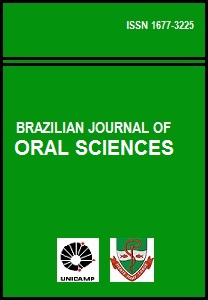Abstract
Aim: This study evaluated the effect of varying the powder/liquid (P/L) ratio on the shear bond to dentin (SBS) and flexural strength (FS) of glass ionomer cements (GIC)s. Methods: Three types of GICs (Fuji II, Fuji II LCi and Fuji IX GP) were mixed using the following P/L ratios: 20% lower than the manufacturer’s ratio, manufacturer’s ratio, 20% higher than the manufacturer’s ratio (9 groups). SBS (MPa) was evaluated and the mode of failure checked under stereomicroscope. FS (MPa), of the specimens (25×2×2mm) assessed using a universal testing machine at a crosshead speed of 1 mm/min. The data were subjected to two-way ANOVA and Tukey’s test for analysis (p< 0.05). Results: The highest SBS and FS (MPa) obtained for Fuji II, Fuji II LCi and Fuji IX were 6.12±2.11 and 16.96±2.73; 11.60±3.19 and 49.58±8.75; 7.39±2.77 and 20.32±2.09, respectively. The interaction between materials and P/L ratios had no significant effect on the properties tested in this study. Fuji II LCi exhibited significantly higher SBS and FS than the other two GICs in all P/L ratios. Conclusions: No significant differences were observed between Fuji II and Fuji IX. Twenty percent variation in P/L ratio had no significant effect on SBS and FS of GICs.Aim: This study evaluated the effect of varying the powder/liquid (P/L) ratio on the shear bond to dentin (SBS) and flexural strength (FS) of glass ionomer cements (GIC)s. Methods: Three types of GICs (Fuji II, Fuji II LCi and Fuji IX GP) were mixed using the following P/L ratios: 20% lower than the manufacturer’s ratio, manufacturer’s ratio, 20% higher than the manufacturer’s ratio (9 groups). SBS (MPa) was evaluated and the mode of failure checked under stereomicroscope. FS (MPa), of the specimens (25×2×2mm) assessed using a universal testing machine at a crosshead speed of 1 mm/min. The data were subjected to two-way ANOVA and Tukey’s test for analysis (p< 0.05). Results: The highest SBS and FS (MPa) obtained for Fuji II, Fuji II LCi and Fuji IX were 6.12±2.11 and 16.96±2.73; 11.60±3.19 and 49.58±8.75; 7.39±2.77 and 20.32±2.09, respectively. The interaction between materials and P/L ratios had no significant effect on the properties tested in this study. Fuji II LCi exhibited significantly higher SBS and FS than the other two GICs in all P/L ratios. Conclusions: No significant differences were observed between Fuji II and Fuji IX. Twenty percent variation in P/L ratio had no significant effect on SBS and FS of GICs.The Brazilian Journal of Oral Sciences uses the Creative Commons license (CC), thus preserving the integrity of the articles in an open access environment.
Downloads
Download data is not yet available.

